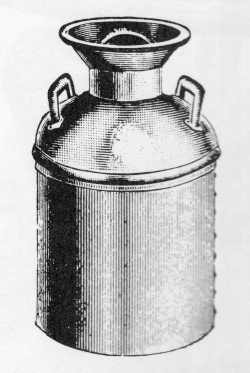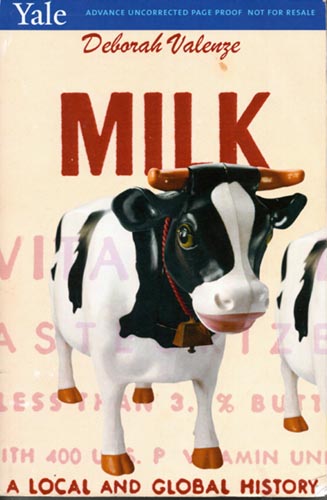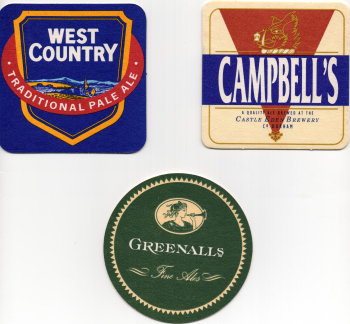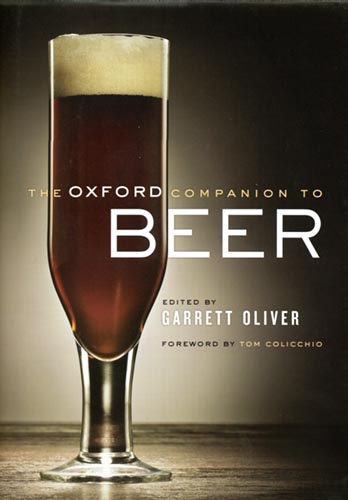A review of two new books, on milk & on beer: Which would you choose?
If offered the choice between a glass of milk or pint of beer, what would you do? You could read about either liquid at some length in two recent publications. Milk: A Local and Global History by the Barnard professor Deborah Valenze appeared earlier this year and The Oxford Companion to Beer edited by the Brookyn brewer Garrett Oliver appeared earlier this month.

Milk has enjoyed a wide press in both Britain and the United States for such a scholarly effort laden as it is with welcome endnotes. Reviewers for newspapers as ideologically and geographically farflung as the Boston Globe and The Telegraph of London have given the book good notices, and Professor Valenze has scored interviews with NPR and other broadcast outlets.
It is an ambitious effort, ranging from ancient Egypt to contemporary Wisconsin with other stops across time and space in Australia, England, India, Mongolia and elsewhere. Valenze flies to a promising start. She cites “the 2009 Ig Noble awards, an annual event in Cambridge, Massachusetts, organized to ‘first make people laugh and then make them think.’” (Milk 1) She promptly ruins everything, however, by intoning “I didn’t laugh, though” because the award went to a pair of researchers who found that named cows produce more milk than nameless ones. This is too serious a subject for humor, because it involves not only “bovine charisma” but also “chivalry and tenderness in the dairy barn.”
We lately have witnessed a flood of histories each devoted to a single food. Subjects range from beef and cod through corn, the oyster, the potato and salt. Reaktion Books has launched an entire “Edible” series covering everything from cake and caviar to tea and whisky. Like the biographer who falls too far beneath the spell of an obscure figure, however, these monographers tend to ascribe unwonted significance to their subjects. Overstatement takes command of many an advocate, and Valenze cannot escape its lure. That is strange, for she identifies the trap only to clamp herself between its teeth: “It may be that every author sees the subject of her book as special, but in this case, I felt I had an arguable case.” (Milk 4) Never mind the clunky repetition; the case goes unmade.
What we get instead is an uneasy condominium of history and polemic burdened by serial revelations of the obvious. It is hard to milk a skittish mare, easy to milk a docile cow; an entirely apocryphal story about Charlemagne’s first taste of Brie was “an early French triumph” and “alerts us to the fact that” during the Medieval period “cheeses, like people, were local in character.” At that time, “[u]ndistinguished but wholesome dairy products were sometimes wedded to staple dishes in remote and rural regions.” Oh, and farmers “had to translate their products--animal hides, meat, wool, butter, and cheese--into credit to purchase the staple crops they were unable to grow on their land.” (Milk 51-53) This mixture of the inane and the intuitive is all too typical of Milk.
Even so, some of these statements manage to engender a certain doubt at the hand of Valenze. She cites a meatless fifteenth century Welsh cawl “described by William Caxton” that bears no resemblance to the meaty modern national dish. It is her lone example of a rural staple incorporating dairy products, and calls it “a sure sign that the Welsh were ignoring dietary proscriptions coming from Rome.” (Milk 53)
Is her description correct despite its divergence from cawl as we know it? Or did Caxton use cawl in a generic way rather than to describe a particular dish? According to Bobby Freeman in Traditional Food from Wales (New York 1997), “[t]here is no translation for cawl. In a literal sense it means soup or broth.” (Wales 106) On what occasions did Caxton think the Welsh ate cawl; was it on fast days or not? Precisely what proscriptions did the Welsh ignore? Did all of the Welsh ignore them? We cannot know because neither the endnote for the assertions nor the bibliography of the book mentions Caxton.
Similarly, Valenze launches a lengthy discussion about the cult of lactation in the Medieval Catholic church. It is based on Mary squeezing drips of her milk into the mouth of St. Bernard, who “deserves credit for his role in increasing the volume of sacred milk in the Middle Ages.” (Milk 48) ‘Deserves credit?’ Valenze explains that “[l]ike most legends, this one is born of numerous conflicting sources. A telltale sign of its ambiguous pedigree is its mysterious origins.” (Milk 43) What? Has she not simply restated the obvious three times? And so what?
Valenze considers the cult widespread, “infinite in its meaningfulness and also very problematic” (Milk 47) in part because “[a]ccording to recent count, 119 similar lactation images remain scattered across Europe,” (Milk 43) but how does that denote ubiquity? It seems that more images of St. Sebastian reside in the Uffizi alone. In any event there is no citation for either the scope of the cult or the number of images.

Jarring contradictions join awkward passages like “[t]he wellspring of general Dutch industriousness.” (Milk 86) Valenze writes variously that by 1344, Parmesan cheese already had “established a prestigious pedigree;” by 1494, “Dutch milk earned comparison to wine and was regarded of [sic] greater value” in “the Rhineland” while “the microcosm of dairying” remained a “bastion of gastronomic barbarism” into the seventeenth century when, however, “‘the best Holland Cheese with red Rinde’” was “‘much sought after by all Nations’” and, in general terms, “[w]here dairying reigned, nearby resided simple virtue” according to the estimation of contemporaries. (Milk 4, 84, 85, 86)
In one interview, Valenze describes herself as an historian of the English dairy industry, but she is not. Instead, she is a historian of women in English industry, including the dairy industry, and the distinction is not without difference. Her self-description refers to an earlier work, The First Industrial Woman that, according to its rear cover, intends to show “[t]hrough selective treatments of agriculture, spinning, and cottage industries… how the rise of values of productivity and rationality subordinated women.” One might be forgiven for wondering whether selectivity may serve to support special pleading or even to mask bias but that is a deeper historiographical inquiry that lies beyond the scope of this review.
Returning to Milk, Valenze’s feminist proclivity leads to some bizarre passages. This one is worth quoting at some length for both its lack of foundation--once again, no citation--and its impenetrability:
“The wish for sustenance and gushing abundance in the form of milk resonated with the daily challenges facing most medieval women…. Milk became not only the product of their own breasts but the ultimate symbol of their well-being. As food, milk assumed an important role in religious experience. Women commonly engaged in the practices of fasting and feeding in order to demonstrate their piety. Such rituals also enabled them to seize control of their situations, catapulting them out of the realm of the ordinary into the extraordinary. Countless tyrannical parents and undesired suitors were thus spurned as women focused on the powers of their own bodies. They had no trouble finding role models for their fantasies about milk in the stories of saints.” (Milk 49)
Did the intercession of saints prevent forcible sex or render marriage contracts unenforceable? Or did lactation on demand keep undesirables away? How did these women control the ‘gushing’ spigots, let alone ‘seize control of their situations?’ And how can a fantasy have a role model?
Passages like that explain why Milk feels a lot longer than its roughly 300 pages, although it never does get around to telling us why cows rather that goats or sheep or pigs for that matter came to dominate dairying, and Valenze ducked the question during her interview with NPR.

The Oxford Companion to Beer is in fact longer, a hefty 868 pages plus tables and appendices. It also is impeccably researched, beautifully written and informative; in short, irresistible. It appears in the familiar format of the other Companions, essays both short and long arranged in alphabetical order by subject.
Until the last decade or so, British brewers measured strength of their beers by reference to ‘original gravity’ rather than percentage of alcohol. The label on every bottle disclosed a range of original gravity within which the beer fell, so that its measurement appeared variable and even uncertain.
Over the years the Editor has asked English people old and young, northern and southern, to explain the meaning of a term they encountered every day. None of them either knew the answer or would admit as much. Typical responses had run along the lines of “Oh yes, it’s quite simply the means of measuring by reference to gravity the nature of the drink” or “you have to understand the notion of original gravity, for beer that is, by determining, so to speak, the gravity that is originally part of the beer as brewed, weight as it were.”
The Oxford Companion provides the lucid and succinct answer. It “is a measure of the solids content originally in the wort [the mixture of water, grain, hops and yeast], before alcoholic fermentation has commenced to produce the beer.” It therefore does not measure alcohol itself but rather is a means “used by brewers to determine the future alcohol content of a beer” and so control its quality and consistency. British beers disclosed their original gravities not for drinkers but for the Inland Revenue; excise tax on the beer rose with its original gravity. (Beer 629-30)
Why is a half-gallon bottle of draft beer called a ‘growler?’ The Companion explains that customers took metal buckets fitted with a lid to fetch draft beer from saloons for home consumption. The buckets allowed gas to escape, making a growling noise in the process (we are proud to note here that we have resisted any fart analogy or joke).
‘Skunked’ beer is literally, or rather chemically, skunky; beer exposed to too much light photo-oxidizes to produce a “pungent odor compound” that “resembles that of the famously malodorous defense spray deployed by skunks.” (Beer 548)
Other essays cover ale houses, coaching inns and the pub; each variety of hop; brewers great and small; the industrial revolution; food to eat with beer; and all the beers themselves.
The Companion pulls no punches about India Pale Ale:
“Of all beer styles, IPA is the most romanticized, mythologized, and misunderstood. It inspires the fiercest debate, the greatest reverence, and the wildest conjecture in the world of beer.” (Beer 482)

It turns out that IPA did not obtain its name until at least five decades after people started to drink it during the eighteenth century in Britain and India. Its great popularity, however, commenced only after the Great Exhibition of 1851 before the beer would decline to near extinction toward the end of the twentieth century, when American craft brewers stocked a global revival. We are no plot spoilers so find a copy of The Companion to learn why.
Our advice here at britishfoodinamerica would dictate choosing beer both literate and liquid over the milk every time.

